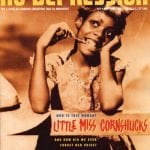Maria McKee – I Like To Use Traditional Elements And Mix Them Up In A Modern Way
There are eclectic artists and then there is Maria McKee. She first emerged as the teenage dynamo fronting mid-’80s roots-rock hope Lone Justice with that voice and them moves and those looks. Few bands showed so much promise and remain so beloved despite major-label machinations that are harrowing even by today’s standards. Veteran industry types still reference Lone Justice as the standard against which label hype is measured. The band issued just two albums, on which personnel shifted and outside producers, songwriters and label honchos wielded considerable influence.
By the time they split, it was difficult to tell if Lone Justice was a failed idea, a callous product of the machine, or a real band that simply had the life drained out of it prematurely. But there was never any mistaking Maria McKee as the real deal. After Lone Justice, McKee went solo, first as a singer-songwriter of shimmering beauty on her 1989 self-titled debut, then revisiting her Lone Justice roots and bandmates with help from folks such as Gary Louris on 1993’s You Gotta Sin To Get Saved.
That album, along with the Jayhawks’ Hollywood Town Hall, Lucinda Williams’ Sweet Old World and Uncle Tupelo’s Anodyne, were all released through major labels during a twelve-month period that now looks like a meaningful milepost along the road of alt-country ascent that’s been paved ever since. McKee, however, decided to take a wicked left turn.
Toward the end the tour in support of You Gotta Sin To Get Saved, McKee began peppering her set with cover songs that weren’t quite, shall we say, high and lonesome. The Flaming Lips’ “Hit Me Like You Did The First Time”, Grant Lee Buffalo’s “Jupiter And Teardrop”, Scott Walker’s “The Plague”, even Prince’s “When You Were Mine” were rendered with relish by McKee, who also took to the challenge of being the sole guitar player for the tour’s final leg by adopting a style heavily influenced by Mick Ronson.
What came next was Life Is Sweet, an angry, angular album that found McKee in PJ Harvey territory and left fans choosing sides of the fence. By way of illustration, the now out-of-print album shows just two customer reviews on Amazon.com — the first a single-star rating headlined “a noble but ultimately failed experiment,” the second a five-star rave that begins, “This is one of the greatest albums I have ever listened to.” Love it or hate it, the album’s title track stands out as an overlooked masterpiece of simple beauty.
Six years have passed since Life Is Sweet, and beyond a short solo tour in 1998, McKee hasn’t been heard since then, save for a couple of striking appearances on soundtracks and compilations. She returns with High Dive, an album written, produced, engineered, even mastered by McKee and her husband Jim Akin, and released April 22 through their own Viewfinder label.
By now, one would expect the unexpected from McKee, and High Dive doesn’t disappoint. For those who know only her rootsier side, High Dive might come across like Ryan Adams joining the national touring cast of Les Miserables. But, as McKee explains, operatic flourishes and theatrical scale come just as naturally to her roots music ever did, maybe more so.
I. I’M REWRITING MY WHOLE VOICE AS AN ARTIST
NO DEPRESSION: Can we start by going back six years to your last solo record, Life Is Sweet, and your parting of ways with Geffen Records?
MARIA MCKEE: Life Is Sweet was shelved by the label, which was hurtful. I know it was derided by some people and also revered by others. Anybody who got that record, in my opinion, is a hero. It was an important step in my career. Everyone at Geffen thought it was my Chris Gaines record, that I was putting on a wig and doing a version of something that wasn’t me, and that I was gonna go back to making whatever kind of music they wanted me to make.
ND: But even at the end of the You Gotta Sin To Get Saved tour, as rootsy as that record was, you were doing some cover songs and performances that pointed in the direction you took on Life Is Sweet.
MM: I’ve been headed in that direction my whole life. I grew up with very different types of music than the typical rock ‘n’ roll lexicon, with Bryan [McLean, Maria’s brother and founding member of Love with Arthur Lee] and my background in the theater. The rock ‘n’ roll thing became a passion for me, but initially it was something that my brother wanted me to do because he heard my voice, conceptualized this whole band, and wanted me to be the next Linda Ronstadt.
ND: How did your relationship with Geffen actually end?
MM: We just got to this point where we stayed at the party too long. I don’t think they wanted to stand in my way, and I was ready to go. I gave them demos of the new songs and I think they got the point: This isn’t just a little phase I’m going through, I’m rewriting my whole voice as an artist.
I have nothing against the major-label system if you’re a young person who wants to make records that people will hear, because if I hadn’t had those years on Geffen and hadn’t had the money to go out and promote my records the way I did, I wouldn’t have a fan base to work from now. I believe in the indie system. I think it’s fantastic and it’s fun doing it ourselves and having control, but I’m grateful for the time I spent in the major-label system. I’m not one of those people who has a toxic reaction to it.




